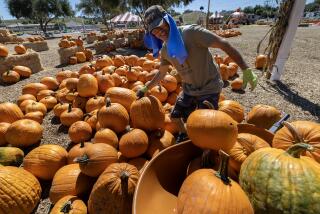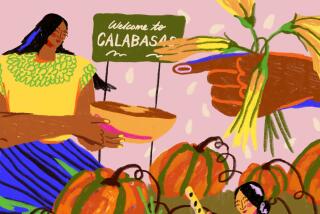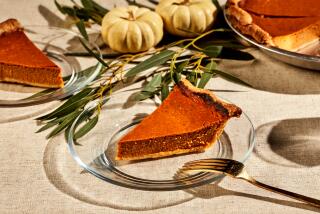Gardening : Trick Is to Plant Now for Halloween Treat
- Share via
June might seem a bit premature to start thinking about Halloween; but if you plan to grow your own jack-o’-lantern, this is the month to plant pumpkins.
Growing pumpkins is a fun gardening project for the whole family. Youngsters love to grow their own jack-o’-lanterns, and parents can grow a few for pumpkin pies. Pumpkins are easy to grow, and although most varieties require a good deal of garden space, there are a few semi-bush types that take much less.
Traditionally, farmers and gardeners divide pumpkins into two categories--pie pumpkins and field pumpkins. Simply stated, pie pumpkins are good for eating, while field pumpkins are usually used for jack-o’-lanterns or livestock feed. Not that field pumpkins are inedible; they can be eaten, but they’re not very good.
Pie pumpkins have sweet, fine-grained flesh, and field pumpkins have watery, stringy, bland-tasting flesh. Some pumpkins are dual-purpose, good for pies and jack-o’-lanterns. Some could even be called triple-purpose since they also have delectable hull-less seeds for roasting.
Following are some interesting pumpkin varieties and the uses for which they have been developed.
Dual-Purpose Pumpkins
Two pumpkin varieties, Spirit and Autumn Gold, are outstanding for both jack-o’-lanterns and pies. Spirit also has another big plus--unlike most pumpkins, it can be grown in limited-space gardens as it has a semi-bush type plant habit that spreads only 5 feet. Spirit produces 10-pound oval fruit, which are colored bright orange; its golden yellow flesh is sweet and of good quality.
Autumn Gold Hybrid is a marvelous new pumpkin, which produces beautiful 7- to 10-pound golden pumpkins that are ideal for jack-o’-lanterns and tasty in pumpkin pies. The pumpkins reach maturity one to 20 days ahead of other pumpkin varieties. Unlike other types, the young pumpkins start turning golden before they become mature, which adds to the attractiveness of the plants.
Jack-O’-Lantern Pumpkins
A variety aptly named Jack-o’-lantern produces beautiful head-shaped fruit that make perfect jack-o’-lanterns. The bright golden pumpkins weigh about 12 pounds each. Seed catalogues advise that Jack-o’-lantern is also suitable for pies, but in my opinion, it’s barely suitable. Connecticut Field is an old favorite jack-o’-lantern pumpkin that is still quite popular with commercial growers for the Halloween trade. It produces pumpkins that weigh between 15 and 25 pounds and are ideally shaped for carving.
Pumpkins for Pies
Here the flavor, but especially the texture of the flesh is important. Most of the prime eating pumpkins come in smaller sizes. Small Sugar, also known as New England Pie or Boston Pie Pumpkin, is the traditional pie pumpkin and has been for many years. It produces small, round fruit that average 7 pounds each and features deep-orange, fine-grained sweet flesh.
Spookie is an improved version of Small Sugar. It reaches maturity slightly earlier and yields greater numbers of fruit. The fruit, however, are smaller, averaging 5 pounds each with thick yellow-orange flesh, which is sweet and fine textured. Although both these pumpkins are small, the vines are large and sprawling.
Prize Winners
Big Max and Big Moon will produce mammoth pumpkins that will win prizes. However, they are not good for eating purposes. Big Max will produce pumpkins over 100 pounds and Big Moon will grow to 200 pounds. Of the two, Big Max has the more attractive shape and coloring. If you are trying for a prize winner, pick off all but three pumpkins on each vine when they reach the size of softballs. Then, when these weigh about 3 pounds, pick two of the three, leaving the best-shaped one. Water often, and feed several times with a fertilizer that’s fairly high in nitrogen. Keep the blossoms picked and this pumpkin will reach an enormous size.
Pumpkin Seed Special
Some pumpkins are grown exclusively for their tasty seeds. They are called naked-seeded pumpkins; the seeds have no hulls, so no tedious shelling is required. A pumpkin called Triple Treat is a naked-seeded variety that can also be used for carving and its flesh makes a pretty good pie. This triple-purpose pumpkin produces small (6- to 8-pound) fruit that are bright orange.
Jack Be Little produces cute miniature pumpkins that are just 3 inches in diameter and 2 inches high. It is a true pumpkin with deep-orange coloring; it is ideal for Halloween decorations. The vines, however, are not small and require considerable space.
Growing Pumpkins
Pumpkins love warm weather and should be planted in a warm, sunny area of your garden. They benefit greatly from a generous amount of compost or other organic material worked into the soil before planting. In addition, add a balanced vegetable fertilizer according to package directions and water the soil thoroughly before sowing the seeds.
Plant pumpkins in groups. In an 18-inch-diameter area, sow a group of six seeds at a depth of 1 inch. Thin the young plants to the two healthiest plants in each group when they are 3 inches high. If planting standard-sized pumpkins, allow 6 feet of space between groups. Giant pumpkins require 8 feet between groups, and for semi-bush types, leave 4 feet between groups.
Water pumpkins on a weekly basis and give them a light side dressing of an all-purpose vegetable fertilizer once a month.
Harvest pumpkins when the shells harden and the stems and plants dry up. Cut the stems with a sharp knife and leave about 3 inches of stem on each pumpkin. Let pumpkins cure in the sun a few days before storing them.
Fresh pumpkin blossoms are a taste treat and are sometimes found in gourmet vegetable markets. Cooked quickly in light oil or melted butter and salted, they make delightful snacks.
It’s fun for kids to personalize pumpkins by inscribing their names on them. Along about late August or September when the pumpkins have fully enlarged but the shells have not yet hardened, use a knife to scratch names or words on the fruit. As the pumpkins mature the names will callous over and by harvest time, be easily readable.
Seeds for most pumpkin varieties mentioned here should be available in local nurseries, especially those that stock Burpee seeds.






